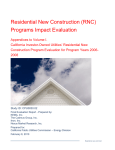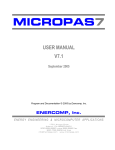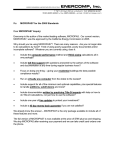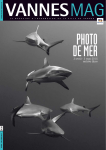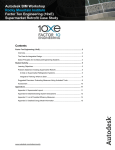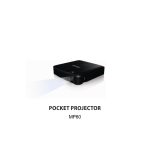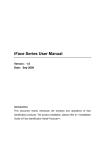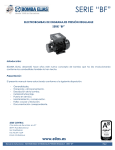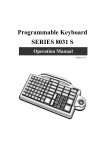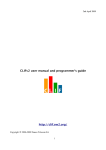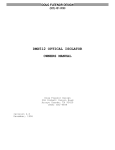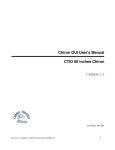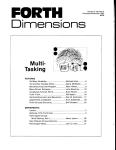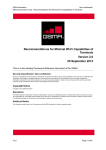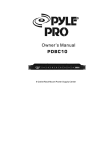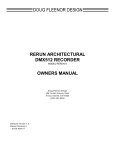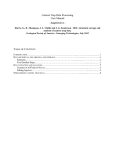Download MICROPAS7 v7.3
Transcript
ENERGY ENGINEERING & MICROCOMPUTER APPLICATIONS ENERCOMP, Inc. 1721 Arroyo Drive • Auburn, CA 95603-9431 800-755-5908 • 530-885-9890 • fax 885-9892 • [email protected] November 17, 2006 Re: MICROPAS® v7.3 Welcome to MICROPAS v7.3 with the newly approved California Energy Commission (CEC) evaporatively cooled condenser model. The CEC approved v7.3 on October 11, 2006 for use with the California residential building energy standards. Other than the addition of the evaporative condenser model, this version yields the same results as v7.2. Attached is the welcome letter from v7.1 and v7.0 describing essential information about the program and its use. Evaporatively Cooled Condensers Evaporatively cooled condensers work by replacing the outdoor unit of a standard air cooled air conditioner with a water cooled unit. These are not swamp coolers and do not introduce any humidity to the conditioned space. From the outdoor unit to the air handler, these systems are the same as conventional air conditioners. Evaporatively cooled condensers take advantage of the fact that the wet bulb temperature is lower than the dry bulb temperature, reducing the energy consumption of the compressor. Compliance savings in cooling climates typically range around 40% of the cooling budget. A sample input file named MP7EVAPC is included with this new version. To model an Evaporative Condenser system, you set the cooling system type to ‘EvapCondenser’ and enter the EERa / EERb (e.g., ‘14.8/16.7’) in the SEER field at the cooling system screen. Freus, Inc. makes evaporatively cooled condensers. Their web site is www.freus.com. If you have questions about these systems and their EERa and EERb values, call Freus at 915-4725729 and ask for Adam. Converting Files from Earlier v7.x A file converter that imports earlier version 6 and 7 input files is provided. The file converter is located under the Other Operations menu. • By default, the file converter looks for files in the latest version 7.2 directory (usually \MP72). If you placed your files in a different directory, or you are upgrading from an earlier version, you will need to change the disk settings to match the directory where your files are stored. You can change the directory by choosing Other Operations, then Edit Settings, then Disk Installation and then HardDisk. To switch to version 7.1 for example, you would then enter ‘\MP71\’ for item 15. • If you want to convert all input files between versions at once, use ‘/All’ for the file name • The file converter will also convert HVAC sizing location data, Appendix IV data and Mandatory Measure data. Run the converter with the file name set to ‘/HVACLocation’, ‘/AppendixIV’ or ‘/Mandatory’ to convert desired data. Number of Systems The addition of the number of heating and cooling systems to the CF-1R has caused some confusion among users and building departments. The only time this new value affects the compliance results is when the verified cooling capacity credit is used. To reduce confusion, a switch has been added that instructs MICROPAS to skip printing the number of systems except if it is required due to the use of the verified cooling capacity credit. This switch is accessed under Other Operations, Edit Settings, Feature Installation number 18. ‘Yes’ instructs the ENERCOMP, Inc. Page 2 program to skip printing the number of systems column whenever possible. ‘No’ includes the column always. New Copy and Paste Feature In most places in the program, you can now use Control-C to copy and Control-V to paste similar to most Windows applications. Press enter first to get into edit mode. A Word About Manuals When you downloaded this version or earlier v7.x versions, you had a choice of downloading a version with the MICROPAS and CEC manuals or without. If you downloaded the version with the manuals they can be found by clicking on the Start button, choosing All Programs, then choose the version of MICROPAS (Micropas 7.3 for this version). You should then be able to select the desired manual for viewing. Please don't hesitate to call us at 800-755-5908 when you have questions related to the use of MICROPAS. You can reach me at Extension 1 or Dee Anne Ross at Extension 2. And be sure to look for software updates and information on training at www.micropas.com. Sincerely, Ken Nittler, P.E. Enercomp, Inc. ENERCOMP, Inc. Page 3 June 29, 2006 Re: MICROPAS®7 v. 7.2 Welcome to MICROPAS7 v7.2! This version features the California Energy Commission (CEC) approved Ice Storage Air Conditioner (ISAC) model. An ISAC makes and stores ice in a tank at night and then melts the ice during the day when air conditioning is needed instead of running a high energy consumption compressor, shifting most cooling energy use to off peak hours. This type of product receives exceptional credit under the time dependant valuation (TDV) compliance calculations introduced with the 2005 standards. Compliance savings in cooling climates are typically range from 25% to 50% of the cooling budgets. Ice-Energy, Inc. makes several off-the-shelf ISAC models that plug into standard air conditioning systems. More on this exciting new technology is available at www.ice-energy.com. A sample input file named MP7ISAC is included with this new version. To model an ISAC system, you simply choose one of the ISAC models at the cooling system screen. Other than the addition of the Ice Storage Air Conditioner model, this version is the same as v7.1. Attached is the welcome letter from that v7.1 describing essential information about the program and its use. The CEC approved v7.2 on June 29, 2006 for use with the California residential building energy standards. Any time you have questions or problems with either the program or the standards, please don't hesitate to call us at 800-755-5908. You can reach me at Extension 1 or Dee Anne Ross at Extension 2. And be sure to look for software updates and information on training at www.micropas.com. Sincerely, Ken Nittler Enercomp, Inc. ENERCOMP, Inc. Page 4 September 21, 2005: Re: MICROPAS®7 v. 7.1 Thank you for your MICROPAS7 order. This version, approved by the California Energy Commission (CEC) on September 21, incorporates changes in the Residential Energy Efficiency Standards that will take effect on October 1, 2005. This version replaces MICROPAS7 v7.0, which was approved March 30, 2005. Please switch to this version as soon as possible. With the release of v7.1, MICROPAS7 is now complete for the 2005 standards. Version 7.0 covered new construction, and v7.1 covers the new Existing plus Addition plus Alteration requirements. In addition, the MF-1R form was added and many other minor changes were made based on feedback from users of v7.0. The results from this version vary slightly from the earlier release, usually less than 0.25 TDV/ft2. What’s the Same The operation of the program has not changed. Screens will look the same. Editing, running and printing are virtually unchanged. What's Different This section covers the major changes in the standards and in MICROPAS. For more details, see the Chapters 1 and 2 of the compliance section in the Micropas User Manual. Cosmetic Changes • C-2R Eliminated. The CF-1R and C-2R are combined into one form—essentially the C-2R with a signature block. • Form 3Rs Eliminated. All walls, floors, ceilings have standard U-factors that are taken from look-up tables. The tables cover most currently known construction types and many combinations of cavity and rigid insulation. MICROPAS is already set up to model all typical constructions. NOTE: A change in the assumptions about wall construction resulted in higher U-factors for walls than we’ve used in the past. Both the Standard and Proposed Designs will use the same U-factors. Changes That Will Affect Compliance Results • Switch to Time Dependent Valuation (TDV). Rather than a source energy multiplier, the standards use energy that takes on different values depending on when it is used or saved to establish the Standard and Proposed Designs. This will place a premium on saving cooling electrical energy and can make the standards much tougher in cooling climates. • New Federal Appliance Standards. New minimum efficiency standards are already in effect for storage water heaters (0.575 Energy Factor) and non-central cooling equipment. Beginning January 23, 2006 new standards take effect for central air conditioners (13 SEER for both package and split system equipment). • Glazing Area. The prescriptive assumption for glazing area is now 20% of the floor area in all climate zones (formerly 16% in some zones). What could be a bigger change is that glazing areas less than 20% will not see a credit. For glazing area less than or equal to 20%, the standard and proposed design will have the same glazing area. • Ducts. The prescriptive (Package D) duct insulation level changed in most climate zones. Zones 1-5 and 9-13 are based on R-6 duct insulation, zones 14-16 are based on R-8 duct insulation. ENERCOMP, Inc. Page 5 Other Changes • Duct Efficiency Credits. There is a new credit for Verified Buried Ducts which are ducts buried under attic insulation. The existing credit for ACCA Manual D Design is replaced with Verified Airflow and is moved to the cooling system section. The credit for reduced duct surface area now has a separate input called Verified Surface Area. All of these credits will require HERS verification or diagnostic testing, and may require a combination of measures (e.g., buried duct credit requires verified insulation quality credit and verified duct leakage). • New HVAC System Credits. There are three new credits associated with the cooling system. They are Verified EER, Verified Fan Wattage, and Verified Cooling Capacity. All of these credits require HERS verification, and some will require a combination of measures (e.g., verified cooling capacity must be combined with the verified airflow). • New Building Envelope Credit. A credit is available for verified quality insulation installation. A HERS rater verification is required for this credit. Installation The new version installs in its own directory and leaves older versions alone so you can continue to use as needed. If you are using any custom printing settings in MICROPAS6, you will need to duplicate them in MICROPAS7. The CD will install MICROPAS and well as the print utility and places two shortcuts on your desktop. In addition, the installer will place bookmarked copies of the Micropas User Manual and standards related documents from the CEC on your computer for electronic reference. Converting Files A file converter that imports version 6 and 7 input files is provided. After you have converted your files, you will need to check the data to make sure it is consistent with the new standards. This is especially true for the opaque characteristics section where your custom form 3s and standard U-factors will no longer be valid. Some tips on using the file converter: • The file converter looks for files in your version 6 and 7 directories (usually \MP60 and \MP70). If you placed your files in a different directory, you will need to change the disk settings to match the directory where your files are stored. • If you want to convert all files between versions at once, use ‘/All’ for the file name • For users who have modified the Appendix IV library in version 7.0, you can merge these with the Appendix IV library supplied with version 7.1 using ‘/AppendixIV’ as the file name in the convert function. Support Thanks for your business. Any time you have questions or problems with either the program or the standards, please don't hesitate to call us at 800-755-5908. You can reach me at Extension 1 or Dee Anne Ross at Extension 2. And be sure to look for software updates and information on training at www.micropas.com. Sincerely, Ken Nittler Enercomp, Inc.





